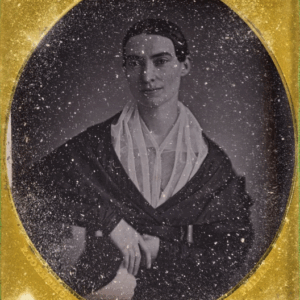JTF (just the facts): A total of 31 black and white photographic works, generally framed in black and matted, and hung against grey walls in the two room gallery space.
The following works are included in the show:
- 21 gelatin silver prints, 1984, 1985, 11×14 inches
- 1 gelatin silver print, 1985, 23×18 inches
- 5 works made from two 11×14 inch gelatin silver prints, epoxy resin, 1984, 1985
- 2 works made from two 20×24 inch gelatin silver prints, epoxy resin, 1986, 1987
- 1 work made from two 11×14 inch gelatin silver prints, epoxy resin, metal, 1985
- 1 work made from two 20×24 inch gelatin silver prints, epoxy resin, metal, 1987
(Installation and detail shots below.)
Comments/Context: Across the history of the medium, when photographers have tried to cross over into photographic sculpture, the results have been decidedly mixed. The artistic translation from flattened two-dimensional thinking into spatial three-dimensional presence isn’t nearly as easy or straightforward as it might seem, and many efforts have been reduced to gluing photographs onto some three-dimensional form, without entirely grappling with the underlying transformation of aesthetics and experience. So when I walked into this show of Paul Smith’s curved constructions from the mid 1980s (as well as a number of his photographs from that same time), I had an immediate lightning strike reaction – here is someone who inherently knows about the dynamics of photographic sculpture.
Smith’s images document the grittiness of downtown life in 1980s New York, as lived in the East Village and on the Lower East Side. Out on the streets, he pointed his camera at rubble piles, condemned housing blocks, demolished buildings, and the dark underside of bridge overpasses, decorating these scenes with engine blocks, car parts, and discarded bottles of Thunderbird. He balanced this grim urban anonymity with intimate scenes of gay seduction, the lazy encounters often taking place in the relative privacy of open air rooftops. But given the backdrop of the AIDS crisis, these tender moments and physical touches set amid the smokestacks are charged with a kind of ghostly urgency.
Smith made his photographs with a homemade pinhole camera, with the film plane built to curve around the aperture. The resulting pictures (some made with long exposures) not only have the dark, tunneled vision associated with pinhole imagery, the subject matter is bent and distorted (almost like photographs made with a fisheye lens), giving both buildings and bodies more exaggerated curvature. The combination of these aesthetic choices make the overall atmosphere more fleeting and moody, the city twisting into rounded grotesqueries and the sensuality disappearing into fading memory. Smith then played with these visual options further in compositions shot through sunglasses, following a spinning hula hoop, and underneath car hoods and swimming pool handrails.
It’s when Smith uses these images as the raw material for sculptural assemblages that things get even more interesting. Each of Smith’s constrictions is built from two prints that have been shaped, curved, and seamed together into vaguely conical forms, with the prints stabilized into hardened elements by expoy resin applied to the back of the prints. In their simplest form, these merged prints resemble looking down into the cellophane wrapped around a bouquet of flowers; in more complicated works, Smith has cut the edges of the prints into more elaborate curves, scallops, fans, and petals, making the resulting combinations more physically bent and torqued. In a few works, he has added spirals of black metal wire that seem to corset the images into tighter twists, and when visible, the backing epoxy resembles the messy sludge found in 1980s era East Village gutters.
The magic happens when Smith takes his already dark and distorted photographs and drops them into this three-dimensional vortex. Between the bends in the pictures and the bends of the physical forms (which aren’t always combined in straightforward ways), Smith creates an engaging range of fun house mirror visual strangeness. Low angle shots of the streets, where the foreground brings us face to face with the sidewalks and roadway islands, seem to bend inward claustrophobically, the dark edges further closing in around us. Black tunnel entrances, the storefront of a hot dog shop, and the flash of cars passing on the corner of 57th and Third all provide details for us to latch onto as the urban fabric around us seems to turn head over heels.
This warping world is made more personal when Smith uses his nudes and portraits as fodder for his constructions. Bodies now come together and intertwine in physical space, the blur of the encounters accented and exaggerated by the bending sculptural forms. The conical shapes pull us inward into these intimate exchanges, as though ephemeral secrets are being revealed. All the twisting makes the mood that much more unsettled and almost despairing, with even a playful love bite fluttering into a swirled jumble of emotion.
That Smith has made these constructions so consistently vital is a testament to his talents in three dimensions – he’s thoughtfully matched and combined imagery and physical structure, building up each composition in ways that maximize the individual interplay. At turns graceful, evocative, elemental, and even tragic, these works find a resonant voice for a specific moment in New York’s cultural timeline. This is a show worth a detour (even in these COVID estranged times), as it brings together historical relevance, formal inventiveness, and satisfyingly disorienting imagery in a manner that is much more than a 1980s time capsule.
Collector’s POV: The photographs in this show are priced at $3500 or $4000 each, while the sculptural constructions are $4500 or $5000 each. Smith’s work has little secondary market history at this point, so gallery retail remains the best option for those collectors interested in following up.



























